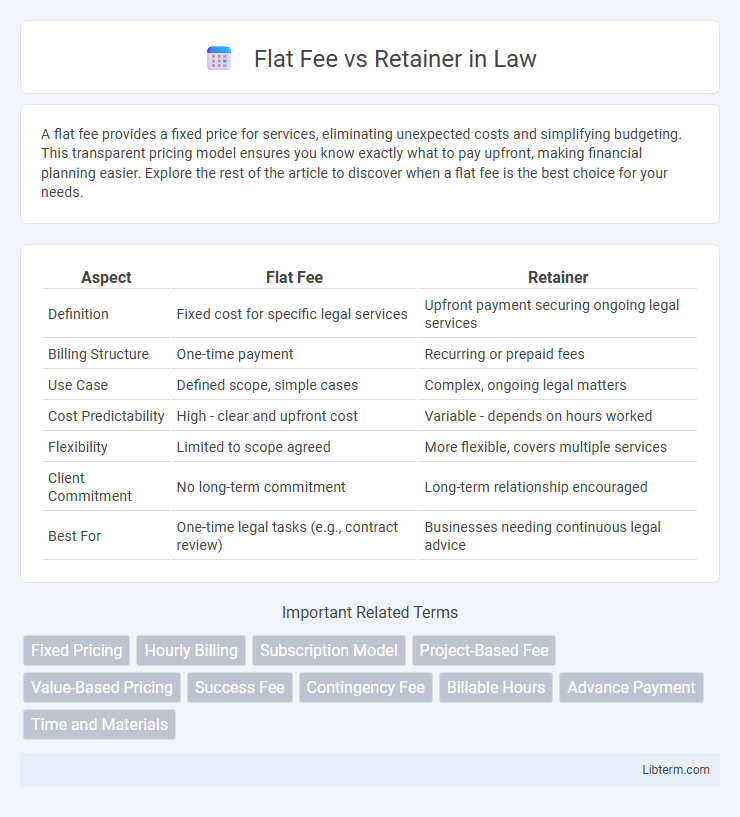A flat fee provides a fixed price for services, eliminating unexpected costs and simplifying budgeting. This transparent pricing model ensures you know exactly what to pay upfront, making financial planning easier. Explore the rest of the article to discover when a flat fee is the best choice for your needs.
Table of Comparison
| Aspect | Flat Fee | Retainer |
|---|---|---|
| Definition | Fixed cost for specific legal services | Upfront payment securing ongoing legal services |
| Billing Structure | One-time payment | Recurring or prepaid fees |
| Use Case | Defined scope, simple cases | Complex, ongoing legal matters |
| Cost Predictability | High - clear and upfront cost | Variable - depends on hours worked |
| Flexibility | Limited to scope agreed | More flexible, covers multiple services |
| Client Commitment | No long-term commitment | Long-term relationship encouraged |
| Best For | One-time legal tasks (e.g., contract review) | Businesses needing continuous legal advice |
Understanding Flat Fee and Retainer Models
The flat fee model involves clients paying a fixed amount for a specific service or project, offering predictability and transparency in billing. Retainer models require clients to pay a recurring fee, typically monthly, granting ongoing access to services and prioritizing long-term relationships. Each model suits different business needs, with flat fees ideal for defined scopes and retainers for continuous support.
Key Differences Between Flat Fee and Retainer
Flat fee pricing involves a one-time, fixed payment for a specific legal service, ensuring cost predictability for clients, while retainers require an upfront payment as a deposit to secure ongoing legal representation, with fees deducted as services are rendered. Flat fees are ideal for well-defined projects with clear scopes, whereas retainers suit clients needing continuous legal support and flexible billing. The key differences include payment structure, billing transparency, and the nature of legal service engagement.
Pros and Cons of Flat Fee Pricing
Flat fee pricing offers clients clear, predictable costs, enhancing budget management and reducing the risk of unexpected bills. This model incentivizes efficiency, as service providers receive a fixed amount regardless of time spent, but may lead to scope limitations or reduced flexibility if project demands increase. However, flat fees might not suit complex or evolving projects due to potential underestimation of required resources, impacting service quality or profitability.
Pros and Cons of Retainer Agreements
Retainer agreements offer consistent legal support with predictable monthly costs, ensuring priority access to attorneys and fostering long-term professional relationships. However, retainers may result in unused hours or fees if services are not fully utilized, potentially leading to higher overall expenses compared to flat fees. Clients benefit from flexibility and ongoing counsel but should carefully evaluate their legal needs to determine if a retainer aligns with their budget and workload requirements.
When to Choose a Flat Fee Structure
A flat fee structure is ideal for clients seeking predictable legal costs for well-defined projects such as drafting contracts, handling real estate closings, or simple estate planning. This pricing model suits matters with clear scopes and limited complexity, allowing both parties to avoid unexpected expenses. Businesses or individuals with straightforward legal needs benefit from the transparency and budget certainty that flat fees provide.
When a Retainer Makes Sense
A retainer makes sense for businesses or individuals requiring ongoing legal, consulting, or creative services with predictable monthly costs and continuous access to expertise. It ensures priority availability from professionals, fostering long-term collaboration and cost efficiency compared to flat fee arrangements suited for one-time projects. Retainers are ideal for complex issues needing regular guidance, such as corporate legal compliance or continuous marketing strategy development.
Cost Transparency and Budgeting
Flat fee pricing offers clear cost transparency by providing a fixed price for specific legal services, enabling precise budgeting without unexpected expenses. Retainer agreements require ongoing payments, creating a predictable monthly or yearly expense but potentially leading to variable costs depending on services rendered. Choosing between flat fee and retainer models depends on the client's need for consistent budgeting versus flexible access to legal support.
Predictability and Scope of Services
Flat fee pricing offers high predictability by charging a fixed amount for a clearly defined scope of services, which helps clients budget accurately without surprises. Retainer agreements provide ongoing access to services for a set monthly or annual fee but may vary in deliverables, requiring clear communication to manage expectations. Choosing between flat fee and retainer depends on the client's need for cost certainty versus flexibility in service scope.
Common Industries Using Each Model
Common industries utilizing the flat fee model include graphic design, real estate, and freelance writing, where project scopes are well-defined and deliverables are specific. Retainer models dominate sectors like legal services, marketing agencies, and IT consulting, offering ongoing support and prioritized access for long-term client partnerships. Choosing between flat fees and retainers depends on industry needs for predictability, continuity, and the complexity of client engagements.
Deciding the Best Choice for Your Business
Choosing between a flat fee and a retainer depends on your business's project scope, budget predictability, and long-term needs. Flat fees offer clear, one-time costs suited for defined projects, while retainers provide ongoing support and flexible services for evolving business demands. Evaluating service frequency, workload consistency, and cash flow will help determine the optimal payment structure for maximizing value and financial control.
Flat Fee Infographic

 libterm.com
libterm.com